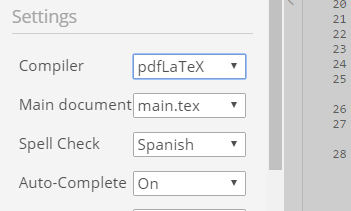LaTeX Error: Unknown graphics extension: .XXX
This error appears when you have used a graphics extension which LaTeX does not recognise. It can also appear when you have used a 'bad' file path which causes LaTeX to get confused.
The allowed image formats in LaTeX depend on the choice of compiler you are using. This is specified in the left hand menu as shown below.

Compiling with pdfLaTeX:
When compiling with pdfLaTeX, you have a wide choice of image formats to choose from. These are listed below
- JPG - This is the most common image format for basic use. It does not take up much space and is useful for inserting pictures in most instances.
- PNG - This is another very common format. This is better for images which require higher resolution as it is a lossless format. Diagrams should be included in PNG format
- EPS - To use EPS images when compiling with
pdfLaTeX, you must use theepstopdfpackage. - PDF - This is useful for including documents in your LaTeX projects. It supports vector images, as with EPS, and as such is very useful when you want high resolution images for large documents such as posters.
Compiling with LaTeX:
When compiling with LaTeX, the only image format you can use is Encapsulated PostScript or EPS. EPS files are vector based, which means that the images are invariant under scaling and is useful for if you want to create large documents such as posters, with high quality images. EPS files naturally declare the size of the image, so it is easier for LaTeX to structure the text and graphics in a nice way.
Common Causes
Using a image format which is not supported:
The most common cause of this error is when an image format which is not supported by a given compiler, such as .gif or .ps is used. The best way around this is to convert to a supported format wherever possible.
Using a bad file name:
Whenever LaTeX sees a full stop, it will interpret whatever follows to be the file extension. Therefore, if there is a full stop in the file name, such as image.logo.jpg, LaTeX will get confused as it will think that the file extension is .logo.jpg. For this reason, you must always name your images such that they do not have full stops in their titles.
Overleaf guides
- Creating a document in Overleaf
- Uploading a project
- Copying a project
- Creating a project from a template
- Using the Overleaf project menu
- Including images in Overleaf
- Exporting your work from Overleaf
- Working offline in Overleaf
- Using Track Changes in Overleaf
- Using bibliographies in Overleaf
- Sharing your work with others
- Using the History feature
- Debugging Compilation timeout errors
- How-to guides
- Guide to Overleaf’s premium features
LaTeX Basics
- Creating your first LaTeX document
- Choosing a LaTeX Compiler
- Paragraphs and new lines
- Bold, italics and underlining
- Lists
- Errors
Mathematics
- Mathematical expressions
- Subscripts and superscripts
- Brackets and Parentheses
- Matrices
- Fractions and Binomials
- Aligning equations
- Operators
- Spacing in math mode
- Integrals, sums and limits
- Display style in math mode
- List of Greek letters and math symbols
- Mathematical fonts
- Using the Symbol Palette in Overleaf
Figures and tables
- Inserting Images
- Tables
- Positioning Images and Tables
- Lists of Tables and Figures
- Drawing Diagrams Directly in LaTeX
- TikZ package
References and Citations
- Bibliography management with bibtex
- Bibliography management with natbib
- Bibliography management with biblatex
- Bibtex bibliography styles
- Natbib bibliography styles
- Natbib citation styles
- Biblatex bibliography styles
- Biblatex citation styles
Languages
- Multilingual typesetting on Overleaf using polyglossia and fontspec
- Multilingual typesetting on Overleaf using babel and fontspec
- International language support
- Quotations and quotation marks
- Arabic
- Chinese
- French
- German
- Greek
- Italian
- Japanese
- Korean
- Portuguese
- Russian
- Spanish
Document structure
- Sections and chapters
- Table of contents
- Cross referencing sections, equations and floats
- Indices
- Glossaries
- Nomenclatures
- Management in a large project
- Multi-file LaTeX projects
- Hyperlinks
Formatting
- Lengths in LaTeX
- Headers and footers
- Page numbering
- Paragraph formatting
- Line breaks and blank spaces
- Text alignment
- Page size and margins
- Single sided and double sided documents
- Multiple columns
- Counters
- Code listing
- Code Highlighting with minted
- Using colours in LaTeX
- Footnotes
- Margin notes
Fonts
Presentations
Commands
Field specific
- Theorems and proofs
- Chemistry formulae
- Feynman diagrams
- Molecular orbital diagrams
- Chess notation
- Knitting patterns
- CircuiTikz package
- Pgfplots package
- Typesetting exams in LaTeX
- Knitr
- Attribute Value Matrices
Class files
- Understanding packages and class files
- List of packages and class files
- Writing your own package
- Writing your own class